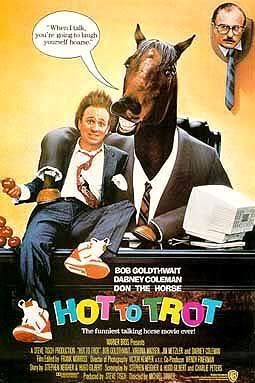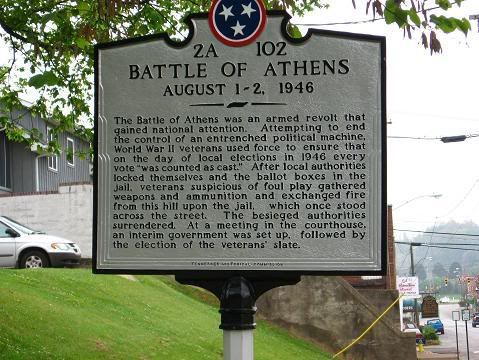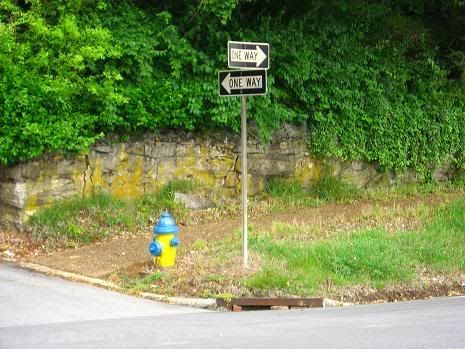The "Novel" part 5This was probably the most incongruous part written. Incidentally, it was also my favorite....
Part 1
Part 2
Part 3
Part 4
In all honesty, this has probably been the most fun to write, so far. It came easily, and that's fun. I've not even really proofread it, so since it came so easily, it probably has the most typographical errors. And since I'm so pleased with it, it may turn out to be the worst section so far. Just formatting it for the site, I think I've got a date issue or three, and I may have switched a characters name a time or two--but such is reading a first draft....
I'll be posting all these to a web page later on. But I'm already running late...The ambitiously named Trainersville Herald-Frontier found its headquarters on the top of a hill at the west end of town. From the steps leading up to its editorial department, you can turn and see pretty much the whole of Trainersville.
I did this, before heading to the door of the newspaper. Looked north, and south. Saw the First Baptist Church (the other Baptist church, the one with Air Conditioning, for those keeping score) bounding the town on the north, and Mt. Zion’s A.M.E. on the south. The newspaper and the Elementary School (on my right) up on the ridge effectively formed a town proper border on the western end of town. To the east, you could see the six-story building the Bank of Trainersville had built a decade or so back–Trainersville’s first “skyscraper,” and past the bank, you saw a mix of houses, trailers and open land. Dots of farms and open land lined the route from Trainersville to Quincy, down State Highway 16 toward the McAllen Paper Mill and the Hiwassee River.
Want a short history of Trainersville and Dickerman County?
I took the bulk of this from a paper I wrote in the seventh grade, though I did some research for this very tome you’re reading now, at the Trainersville Public Library, on a night when a softball game was rained out.
Those first settlers of Dickerman County, religious outcasts who believed that the Holy Trinity actually consisted of God, Jesus and John Quincy Adams, founded a church and a post office on the banks of the Hiwassee River in the early 1820's, appropriately after the third leg of the Trinity.
The county was named after Jonas Dickerman, a hero of the Revolutionary War of much lesser renown than he desired (though twice as much as he deserved) and later Indian Removal Artist, who recieved a huge tract of land in payment for his services to our young country.
Jonas found religion late in life, after a meeting then president John Quincy Adams. It was a brief meeting, at which the President Adams shook Dickerman’s hand, thanked him for his service to our country. Not long after the meeting, Dickerman’s many maladies cleared and quickly.
Dickerman, a pleasant man, to be sure, was renowned less for his Revolutionary War heroics and more for his many, many maladies. At various points in his life, Dickerman had been laid up with any number of maladies...indeed, it might be remarkable that he made it to the ripe old age of 93, except that you need to consider that the man spent more than half his life in bed, recovering from any number of illness or injury. Granted, he spent much of his life sick, but he spent more than equal amounts of time in various states of recuperation.
At various points in his life, it is written that Dickerman found himself laid up with busted knees, shoulders or in one case, what is described as “Busted Skull.” Likewise, records and Dickerman’s own journals show that the colonel found himself suffering at various points from any number of influenzas, respiratory ailments, bronchial infections and pneumonias as well as a vague but long-lasting bout Dickerman suffered during his years spent living hunting in upstate New York , something his doctors refer to simply as “The Dropsy of Five Nations.”
Nor were his lungs the only issue: Various intestinal maladies seem to be something of a speciality of Col. Dickerman. For a great deal of his life, he could only stomach a weak corn-mush and milk as his only form of sustenance. Dickerman’s journals are lined with descriptions of the stomach issues he suffered from most of his life, most of which doctors would probably ascribe to severe lactose intolerance. But along his way, in his travels as an Indian Tracker, Dickerman seems to have picked up every water- and food-borne intestinal bacteria that one could pick up in late 18th and early 19th century America.
“Dickerman suffers again from diarrhea,” is a line found in a great many doctor’s journals of the time. Little can be attributed to this, with the exception of one physician’s opinion that “Dickerman would do well to have his meat cooked a little more....” though this is less a medical opinion than a statement of a doctor who served as his hunt party’s launderer as well. It seems that Dickerman believed rather stringently that it was entirely too easy to cook all the taste out of a piece of meat, be it deer, pork or beef, and often times a hunt on their party would end with an entreaty from Dickerman that they “run a hunk of meat on a stick through the flames a couple of times and feed me it [sic].”
And the opinion of the launderer was that Dickerman might have better luck keeping clean white shirts if he weren’t constantly dripping the blood from barely cooked meat all over his apparel.
Despite standardized medicine not quite having come into full effect in the time, there is one thing the medical professionals of the time all agree upon: Dickerman was a man of prodigious appetites, but he was also incredibly picky about what he ate.
In that there was little besides meat that he would eat.
Let it be known that there was not an animal Jonas Dickerman would not eat. Cow. Pig. Chicken. Duck. Sheep. All were game. Squirrel, rabbit and possum were not all that unusual for the day, either. But Dickerman’s own journals detail the eating of dogs, cats, rats, snakes, gophers, woodchucks, moles, voles and field mice. There is one story, highly debated, about whether Dickerman’s late return from the War of 1812 was truly because he wouldn’t pay an innkeeper’s price for a meal, and decided to follow through on his threat that “he’d cook and eat the horse he was riding before paying 7 cents for an overcooked hunk of steak!”
One local scholar maintains today that Dickerman’s intentions in moving to the Appalachian mountain area was simply the first part of a plan to lead a winter-time expedition across the mountains, in hopes of getting trapped in the ice and snow, so that Dickerson might be able to dine on his traveling companions, and that the only thing that kept that course from being taken was Dickerson’s discovery of religion.
It’s a meandering history, but I’ve said all that to say this.
On the day Dickerman met with President John Quincy Adams, he was in sad shape. It was October of 1827, and doctors were in a frenzy to determine the reason for Dickerman’s declining health, this time around. He arrived to meet the president, suffering from a pallor in his complexion, covered in bruises. His gums were bleeding, his hair was falling out. Dark circles surround his eyes, and he had suffered two nosebleeds that day, the second of which he’d unsuccessfully attempted to stifle with the cuff of his shirt.
Further, Dickerman’s tongue had inexplicably swollen on him, and rendered any attempt at speech a matter of untranscribable and undecipherable gibberish.
The legend says that Adams shook Dickerman’s hand, granted him the huge tract of land in lower East Tennessee, and soon thereafter, every one of Dickerman’s symptoms cleared up.
Clearly, it was a miracle.
Jonas Dickerman had most likely intended to curse Adams. As much is said in his journals: “the man who stole the presidencey [sic] from General Andy Jackson deserves to be spat upon, and to be made to clean out the stables with his hands and mouth....”
But because his tongue was swollen, he was not. Dickerman took this as a miracle from on high. John Quincy Adams then granted Dickerman a huge tract of land on the Hiwassee River in Tennessee, in thanks for his battles against the British, the Indians and all the enemies of the United States of America. Dickerman likewise took the presentation as a divine gift, a display of God’s, Jesus’ and John Quincy Adams’ forgiveness.
There are two more things that need to be mentioned here.
It is most likely that day that neither God nor Jesus, and especially not John Quincy Adams stilled Jonas Dickerman’s tongue. Also, most likely, they did nothing to cure him of his hair loss, sallow complexion, bruises or bleeding gums.
More likely, it was oranges Dickerman had eaten for breakfast that cured him. Dickerman had requested two pounds of bacon that day, but was denied such by the hotel staff, as none was on hand (Dickerman had eaten the whole inn’s supply in the previous two days–remarkable, as it was easily a month’s supply for an inn the served many an important guest in nineteenth century Washington, DC). In lieu of bacon, Dickerman had to settle for a pair of oranges. Oranges he enjoyed so much he bought 3 crates to take with him on his return home, to prepare to travel to his new land in East Tennessee.
Looking back, Dickerman’s diet of meat and little more had left him a little wanting for certain nutrients, all part of what we now call “a balanced diet.” Chief among them that day was Vitamin C.
It now seems that Jonas Dickerman met with the president while suffering from the worst stages of Scurvy. And it was not John Quincy Adam’s divine intervention that saved him. Rather, it was a now constant source of Vitamin C.
And while we can discuss the scientific vs. religious ramifications of having met John Quincy Adams until John Quincy returns with Jesus, there is one more thing: The last thing we need to talk about in the particular manner is the fact that records show that Jonas Dickerman, in fact, never shook that hand of John Quincy Adams.
Jonas Dickerman, as we said, was a man of large appetites. That appetite was not limited to food and drink.
I suppose it depends on your stance on such stories, but it is either fortunate or unfortunate that the ladies of the night of the late 18th and early 19th centuries did not keep as detailed a record as did the medical professionals of the time.
What is known is that Dickerman was renowned for his sexual appetites and his near nightly use of the ladies of the night. Indeed, it was such that kept him from being a prominent member of the puritanical church society of his native upstate New York.
And the conditions of contraception and protection being what they were in pre Civil War America, there are any number of maladies that Dickerman could have (and probably did) pick up. And spread, for that matter.
What is generally agreed upon now, is this:
In 1827, when Jonas Dickerman met John Quincy Adams, the President of the United States, he was suffering from the tertiary stages of syphilis. When Dickerman was supposed to meet with Adams, he was very nearly blind because of his sickness. He told his closest confidant that he could tell “light from dark, but little else.”
“Point me at the President,” Dickerman told that confidant, reportedly at the time when Dickerman was supposed to meet the president. Now whether that aide could understand Dickerman with his swollen, scorbutic tongue is not known. So we don’t know if the aide simply pointed Dickerman at the wrong man, or if John Quincy Adams, upon seeing the ghoulish, thin-haired, bleeding, sallow man decided that discretion was the better part of valor, and sent an aide of his own to shake the hand of Jonas Dickerman.
Either way, it was never told to Jonas Dickerman that he did not meet with John Quincy Adams. He went to his grave (some 16 years later...if you can believe that....) having founded the First Church of John Quincy Adams on the banks of the Hiwassee River in Tennessee, some six miles from where present day Trainersville was founded.
----
It is also not known whether Adams intentionally gave the tract of land that became Dickerman County to two men or not...perhaps he expected Dickerman to be dead of whatever number of curses he was carrying soon enough.
But in truth, John Quincy had indeed gifted the tract of land to two men.
The second man, a James Quentin Edwards was also gifted the land, for his brokering of a logging treaty with the Five Nations in upstate New York.
Dickerman’s party arrived first. They founded a church, and the post office. And they set up their own logging camp on the banks of the Hiwassee.
Edward’s party arrived three months later, surprised to find a port, a church and a working brothel in a town called “Quincy” on the land he was supposed to have owned.
I mentioned that Dickerman County was founded by Religious Outcasts. I apologize if I misrepresented them in this way. They were outcasts, to be sure, but not necessarily because of their religious beliefs. These people were outcasts, but largely because they had been deemed by the society of the time to be less than worthy. Some were petty criminals, expelled from their towns...some were physically deformed, others mentally challenged. And a few were just plain ornery folks who didn’t take with the ideas of the time, including quite a few women who just enjoyed wearing men’s pants. They had all fallen behind Jonas Dickerman for various reasons, but there was one thing that had bound them. They were all Terribly, Wonderfully religious. Devout, devout creatures.
And they had fallen behind Jonas Dickerman after he had taken the Lord, Jesus and John Quincy Adams as his saviour. Also, they fell behind him because he was practically giving the land away in his new county–Jonas Dickerman was a lot of things: Indian Killer, Wonderful Singer, Blind as a Bat...but good with money, he was not....
Anyway. The initial populace of Dickerman County was made up largely of Outcasts who were Religious. Hence: religious outcasts.
Although that stuff where they believe John Quincy Adams was the third leg of the Holy Trinity would have been enough to make them outcasts in that society, had word of their unique beliefs made it much further than the banks of the Hiwassee.
There was a skirmish between the two camps. The Dickerman Camp won out. The fact that their fighting force was made up mostly of the deformed, whom it was believed had little to lose, combined with the Edwards Party’s consternation at having traveled 1100 miles overland when there was a working boat dock on the river, made the fight a short one.
There was one death.
James Quentin Edwards was hanged. In part because of the tiresome, overland route his party had taken to reach his claim. In part because a blind and (almost certainly) crazed Jonas Dickerman believed Edwards to be a spy for the Indians. But mostly because his name, James Quentin Edwards, was taken as a perversion of the name of one of the holy trinity, and he was deemed blasphemous.
Luckily, attitudes had changed somewhat when Jesus Estrada moved into Dickerman County, in 1970.
-----
Trainersville’s history is a little easier to tell.
Trainersville is called what it is because it was built at what became confluence of several rail lines that wove themselves through the south, hauling coal, timber, hogs and people from some place or another. Trainersville most probably wouldn’t have come into being if it weren’t for the railroads, as the only other tangible assets we seem to have are pine trees and mosquitoes. In fact, legend has it that the Cherokee word for the whole area was “Mosquito Swamp,” and that they laughed at the white people when they moved in, for their ignorance.
The original settlers’ name for the town had been Fulgation, and it was founded some 6 years after Quincy, by some of those original settlers of Quincy. Shortly before the Civil War, work began on the train lines that would run through Trainersville, even through the Civil War. Depots were built. Any business that catered to the train industry, whether it be iron works, timber cutters, or watermen found root in Trainersville. Hospitality businesses came into being, be they inns or restaraunts. Even the burgeoning whorehouse industry eventually moved its headquarters from Quincy to Fulgation.
More and more, though, people were calling the town Trainersville, since most of the population had moved in to support the railroad.
And Fulgation, it was decided, was not an appropriate name for a town dedicated to the railroad. Mostly because it was such an ugly sounding word, but also because of the religious implications it had for the small area: most of the natives believed Fulgation was called that as an attempt to add on to the mythos of heaven...how most Christians strived for heaven as their prize, those who listened to the word of John Quincy Adams strove for a whole other level of heaven: Fulgation.
Plus, in 1848, John Quincy Adams died.
By 1853, he had not yet returned from the grave. Not in a manner so that he announced himself, anyway. So, it was pretty much decided that John Quincy Adams either was not holy, or he was simply enjoying heavenly fulgation by himself, and he was not out to help the settlers of the town against the onslaught of railroadmen.
Trainersville became that officially in the fall of 1853.
There’s not much left to tell about Trainersville, except this:
General William Tecumseh Sherman leveled Trainersville in his March to the Sea, during the Civil War. It was a railroad hub. It held strategic value. And a great many of the deformed that had founded the county still had their ingredients in the genepool.
Sherman is supposed to have said, as he made his headquarters in the Velvet Shrub, what had been up until 1862 the nicest brothel in town: “Even if this wasn’t a filthy rebel haven, I’d wipe this horrid, freakish place off the face of the Earth simply to satisfy my own sense of human self-interest.”
Trainersville, in all logic and honesty, probably shouldn’t have been rebuilt.
Using the reasoning that so many have always used: we did it this way before, folks rebuilt the train lines despite the sand and clay soil, despite the scourge of God mosquitos and despite the fact that the Appalachian wilderness seemed to encroach upon the attempt at civilization as soon as you turned your back on it.
But rebuild they did.
Little else exciting or pertinent to this story has happened in the 150 years since. We were the last county to outlaw prostitution in the state, doing so right around the same time Congress placed a prohibition on alcohol. The legal booze came back, the other did not. There was a brief gun battle over voting fraud just after World War 2.
There is one more thing.
In 1966, Jesse Cochrane, the one and same whose ass-crack hangs out of the AMC Gremlin, made national noteriety when, as a 10-year-old, wandered into one of the many limestone caves, in the area, and emerged 21 days later, after having been given up for dead, from a cave not far from where my Dad lived with his parents, off route 38.
To this day, Jesse has no memory of his time in the cave.







